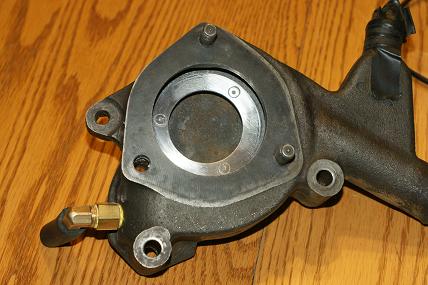
Getting better coolent flow in the Triumph 4 cylinder engine
The back of the engine tends to run hotter than the front. Here's a suggestion to help:
I do not block the heater valve port off. I have found that if you block that port with a plug it restricts the flow of water through and around cylinders 3 and 4. I normally insert a fitting with a nipple, and attach a short piece of hose routed to the heater pipe on the left side of the engine which comes from the water pump housing. On street cars I tell my customers to leave the heater valve cracked to aid in the flow of H2O around 3 and 4. What is the lists take on this?
Ed Barnard
I run the heater pipe to a pressure tank in the battery box location, then over to the back of the head. I think it helps with flow around number 4. It a 1 quart Canton tank.
Bob Kramer
In Jack's latest engine iteration he ran a pipe from the water pump to the hole at the rear of the head.
Tony Drews
I do this on all my engines. Peyote originally had a feed to a modified rear freeze plug but Tony Garmey converted it to the rear head port.
Bill Babcock
If you think about the way it is designed, the location of the hottest point depends on the design of the head gasket. If the head gasket has most of the flow going up at the rear and just a trickle in the front portion, then the hottest point will be at cylinder one. If there is a lot of upward flow near the front and little at the rear, the hottest point will be cylinder 4. If you take water out at the heater port you will encourage flow to #4, but #1 will receive less water, so it will be hotter. With a little experimentation, the size of the holes could probably be optimized so that 1 and 4 are at the same temperature.. I think the stock gaskets cause #4 to be hottest. I like the way Mordy does the holes in his gaskets with big holes at the back.
Larry Young
I had no luck with altering the holes sizes of the steel gasket. Each time I'd enlarge the backwards holes the engine went warm and spilled water. So I run the gasket as it comes and run a hose from the water pump to the rear hard water port.
Chris
My Morgan suffered from what a lot of TR engined Morgans suffer from, namely radiator boil-over and slight overheating after a brisk run. I removed the pump and its housing to do some flow testing using a hand drill to spin the pump at different RPMS. I determined that the stock pump will not pump at all when the engine is slow idling, and will not even begin to pump at almost twice slow idle speed. I'm compensating for the speed increase given by the larger crankshaft pulley. I took the pump off the housing and measured the end clearance using some plumber's putty and discovered that without a gasket, the end clearance was 80 thousands of an inch.
We have quite large pumps where I work and the end clearance on some of those pumps are only a few thousands of an inch. In particular, we have a set of pumps that need to have discharge pressures matched, and one, one thousands of an inch will result in a 20 kPa difference on a nominal discharge pressure of 1100kPa. So, 80 thou without a gasket on the tiny TR pump? No wonder it doesn't work. Apparently, an end clearance of 75 thou is recommended. I can tell you, that even at 40 thou, the clearance is still so large it won't pump effectively.
I added a 77 thou steel spacer to the recess in the pump housing and riveted it in place with flush steel pop rivets. With a gasket, the end clearance is now 7.5 thou and the pump works like a pump should. I repeated the experiment and the pump starts pumping at about 400 rpm on the drill with 4 times the flow it had at full speed on the drill before, and double that speed at full drill speed (about 8 times the flow). I must mention too, that this was with the stock 4 bladed impeller. I do not think that the 6 bladed impeller offered by some would be much more effective without the end clearance corrected. The experiment I did was rather crude, but it did definitely show that the pump was not working as it should. Also, my experiment was done with cold water, not hot water mixed 50/50 with antifreeze which requires even higher speeds to obtain the same mass flow

Fred Winterburn
Retturn to the page top
|

![]() TRIUMPH Contents
page > Net Nuggets contents > getting better coolent flow in the Triumph 4 cylinder engine
TRIUMPH Contents
page > Net Nuggets contents > getting better coolent flow in the Triumph 4 cylinder engine
